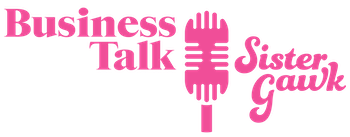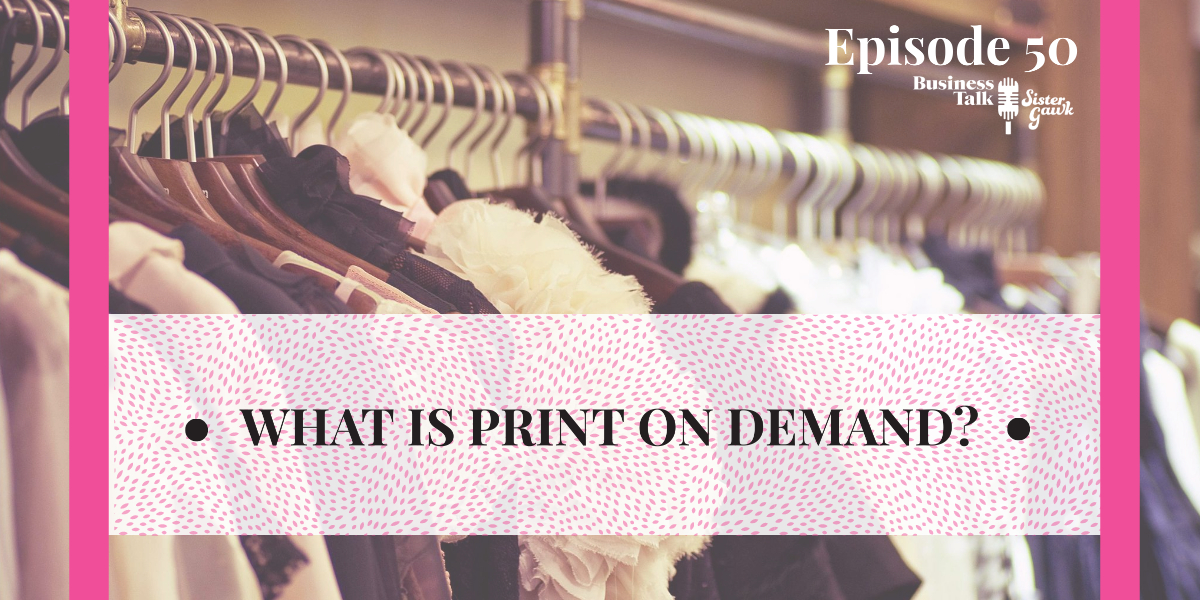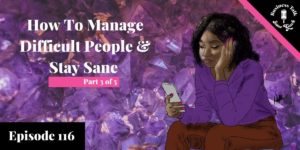This week, we cover the concept of print on demand to understand how people are doing it, and what different approaches are out there. This is a great episode to listen to if you’ve ever wanted to try it for yourself!
Welcome to Business Talk Sister Gawk! I’m Bekkah. And I’m Ruthie! And today’s episode is “What Is Print On Demand.”
Ruthie: All right so, Bekkah, tell us a little bit about print on demand and how it works.
Bekkah: Okay, so print on demand is a concept that some people aren’t familiar with so I’m going to try to explain that first.
Ruthie: And by “some people” she means me. I was really confused earlier so you explained it to me and I’m excited to hear your explanation again.
Understanding How Print on Demand Works
Bekkah: Okay, printing on demand means that nothing is created until it is demanded. If you have an idea, let’s say you have a picture and you’re like, “Wow, this would look really great on a t-shirt!” There are a ton of companies out there that do print on demand where you can upload your design and it superimposes that design on a t-shirt or a face mask or a pillow even. When somebody sees that product, let’s say you create a listing of that for sale on their website and somebody sees it and goes, “Wow! I want that! That’s a great design!”
When they complete their order, it creates basically the demand for the product to be actually created or manufactured. Let’s say somebody bought one of your pillows. It sends that company information saying, “Okay, print this design,” and that gets printed on a pillow, created, and shipped to the customer. Nothing will be created until it is demanded or printed until it’s demanded.
Ruthie: Okay, so basically the advantage of this would be that you don’t have to have a whole bunch of inventory of pillows with your design on it in a warehouse somewhere. It’s only created once there’s a demand for it. What are some options for using print on demand?
Bekkah: Yeah, so we originally got started a little bit in this – I did a lot more of a deep dive because we spoke with Katie Allen a while back about her art and illustration business. If you missed that episode definitely check it out and when we talked with her she talked a lot about Red Bubble and I was like, “Oh, I need to know way more about what this is!”
Red Bubble is more of a website for promoting artists that want to create their art and see it actually on tangible products. Another place like that would be Fine Art America. There are a bunch of other places that are not just niche towards those artists but people in general who are getting to a lot of product out there. Printful, Printify, Merch by Amazon, Teespring, Cafe Press – those are a lot of different ones. Now there are a ton of differences between all of those and why you would choose one over another.
What Are The Different Print on Demand Strategies for Businesses?
We’re gonna start with strategies. There are a lot of different print-on-demand strategies and why somebody would choose to use print on demand. Print-on-demand, like Ruthie said, it allows you to not have inventory sitting around and it allows you to find a niche audience and expand to their needs as you see your product purchases. Let’s say you’re a designer and you’re just trying to find out who your true audience is and what do they like?
Some people as a strategy will just work on cranking out designs and slogans or whatever that hits a niche and see what sticks. Now that’s a really time-intensive approach. If you like to design and you love coming up with catchy phrases or whatever that can be a great thing. Ruthie has a question.
Ruthie: It’s not really a question. It’s just a comment. I think one of my favorite things is going through aisles at Target over in their stationery section when they’ve got all those notebooks with these supposedly “really deep” scenes on top of them. And then I read them and I’m like *in a semi-mocking tone* “take control of today” or like – and I read them super dramatic as I’m trying to be all motivational or something because I’m like what is the purpose of this?
Am I supposed to say that to myself every time I look at this notebook? I just chuckle every time anyway. If you need a good pick-me-up and don’t want to pay for a motivational speaker or a life coach just walk down the stationery aisle of Target.
Bekkah: Yeah, another strategy they would use for print on demand is because they want to build a unique brand. Say they’re an artist or they have a specific message that they want to continue to promote or whatever. Sometimes we actually talked to somebody who utilizes print on demand for their merchandise associated with their business way back in the day with 30West. Candace Sjogren talked to us a little bit about that.
Ruthie: Episode two.
Bekkah: Yeah.
Ruthie: Amazing!
Print on Demand: A Great Way to Sell Your Merch With No Up Front Costs to Your Business
Bekkah: Oh my word! So long ago! So that can be something if you’re just trying to get your business brand out there but you don’t want to have a ton of t-shirts or whatever in stock. You can just say, “Oh, buy it here!” and then it automatically gets printed when they need it. Another way that people use this is for creating a mass inventory to see what sells. We kind of talked a little bit about that in terms of an artist finding their niche but other people use it to just see what’s actually going right now.
That can be a strategy that I think in the next like six months to a year is gonna inundate print on demand to being like, “Oh my word!” everyone’s gonna be like, “I cannot look at another snarky t-shirt!” and I see that already happening because like we talked about a little bit in the past with the drop-shipping, it was the get-rich-quick scheme early on and now print on demand is the sub-baby of that.
People are like, “Oh! How much money can I make doing this?” Just keep that on the rise that suddenly everyone’s gonna start selling snarky t-shirts that are just slightly twisted to say a little bit different of the same saying. That’s why you’re seeing all those ads for those things.
Ruthie: What would be the difference between print on demand and drop-shipping then?
Bekkah: So drop-shipping is basically having a product that is shipped directly to your customer that you don’t touch.
Ruthie: From a manufacturer?
Bekkah: From either a manufacturer or a supplier. Now in this case, this would be a manufacturer. Print on demand is a sub-category of drop-shipping. Okay, does that make sense?
What Are The Print on Demand Businesses I Can Use?
Ruthie: Yeah so then it would be like when you go to that website as opposed to going through Amazon you’re going to like Red Bubble and that would be the platform that you’d purchase it from?
Bekkah: To print on demand, yep, to manufacture that product. Now Amazon actually does have this too. It’s called Merch and they’re very selective now about who they let in that program. A lot of people start with a place like Printful or Teespring or whatever and they will then, once they have a lot of sales and they’re like, “Yeah, we’re a reputable company. We’ve been doing a good job!” They can apply to the Amazon Merch program where Amazon will fulfill that print on demand and get it out to those people and handle all the customer service for them in the future.
But you have to be before like we had mentioned in our last episode when they were beta testing it, it was like, “You want to be an Amazon Merch? Come on in!” and now that they are like, “Okay, we want to only work with people that are growing their businesses and legitimate because that’s a lot of wasted time for us.” It’s very selective in who they allow into the program now.
Ruthie: Kind of what I was hearing before when you’re mentioning the different tactics and strategies that you can use it sounded a lot like just pump out a bunch of things and figure out what works, but is there any way that you could use user data or customer data to figure that out before trying to get all your own stuff? What are ways that you can look at the industry already?
Using Print on Demand to Serve a Niche Market
Bekkah: Yeah, a lot of times what you want to do is think about a niche. I’m not saying these are completely different approaches. Some artists are like, “This is my thing. I’m just doing this to get my name out there because I just want to keep creating art,” and that’s great! Do that. I’m not going to say that you’re going to get a lot of exposure all the time because people are either purchasing because they know you and they want to support your business or people are buying gifts because it’s within a specific niche of people.
Like say somebody who’s a wrestler – you know back in the day before all print on demand, you would get these catalogs for your cheerleader squad and there would be all these little “eat, pray, cheerlead” or whatever. “Live, love, laugh” or whatever, all of those different sayings but specific to that group of people, right? Well, now you can just say “t-shirts for a cheerleader” on Amazon or wherever else you’re Googling on the internet and find a whole bunch of these catchy sayings.
That’s a place you can start looking to see if there’s a niche that hasn’t been served there. Just see what else is out there already and say, “Okay, well, there’s a lot of competition in this category. I’m not gonna go after it,” but if you already are a part of a niche it might be something where you just even start making things for somebody that is an inside joke within the industry. An example of this would be our Woodworking episode when we talked with Nate Turner. He was like, “You can never have too many clamps.”
That’s something that apparently all woodworkers really can resonate with! That’s a funny thing so those kinds of things. What is it that makes that sub-group of people laugh? That’s a good way to figure out what is going to sell within that category. I’m not saying that everybody needs to do that because, quite honestly, it’s not going to be very successful for very long, because there are just going to be an over glut of competition very quickly.
Ruthie: We did also mention a really cool tool called Jungle Scout in our last episode that basically pulls data from Amazon of what’s selling so you can use that and trying to figure out what is moving in the market right now as you kind of plan for what you would like to um use for print on demand. Now we’re going to transition into some what the advantages are with print on demand. Tell us a little bit about that, Bekkah.
Using Print on Demand as An Artist to Get Your Name Out There
Bekkah: Yeah so it’s a good place to start if you have limited capital investment initially. If you’re not really sure if something’s gonna sell or if you’re not really like, “I know that this is my art and I’m gonna sell a bunch of mugs,” or whatever. It can be a good place to try a few things and just give people your business card and say, “Yeah, check me out on Fine Art America!” or if you want to do full-blown get more into this it could be through Amazon. It can give you more time to be creative. That’s another advantage.
If you’re just trying to do more art and you enjoy that and you just want to throw stuff up, that can be a place to do that. It’s a great place to get your feet wet in retail without having to store a bunch of stuff. What I actually see as the advantage for specifically print on demand, where I see people actually scale is they start with print on demand and see what’s actually selling, and then over time they actually do go out, work with a graphic design place that does the printing, and orders bulk amounts. Then either fulfills those orders themselves or does fulfilled by Amazon and ships it into the warehouse.
What Kind of Profitability Does Print on Demand Have?
The reason that there’s a difference in that scaling process is that the costs for print on demand are really high. I was looking at a bunch of different services. Some of them they make you pay a subscription fee even to get on there. And if you sell through Amazon after you have 150 listings you have to have a professional account. That means you have to upgrade and pay like $39.99 a month. There are a lot more operating costs as you scale but if you start with a different place like printful, for example, you’re doing a mug or whatever your return on investment of profit margin after they’ve printed everything and shipped it is like a $1.45 or something. It’s really low.
Ruthie: Mmm raking in the cash!
Bekkah: Which I mean if you’re making millions of sales on one product you’re gonna be good. I mean that’s great but a $1.45 for a profit margin on let’s say for a $20 item, that’s really low. Definitely, a disadvantage is that cost of print on demand. Another advantage is you can integrate with a lot of different platforms really easily. If you just want to keep designing and throw stuff up a lot of these places have really invested heavily in integrations.
Basically, anything that you create and put your graphic on, whether it’s like a mug or whatever, it can auto-populate into Etsy or into Amazon or some places. even do eBay. That can be really nice because it will push to all these different platforms and you just have one place that you’re creating all those products through. Then you don’t have to manage any of the shipping. Also, as you scale, you can run your processes faster with that by having everything in one place that’s pushing to those different places and managing inventory. Yeah so there are a lot of different things with that for sure.
What Are The Disadvantages of Print on Demand?
Ruthie: Yeah, so now tell me about some disadvantages of print on demand.
Bekkah: Obviously, you’re going to be limited to the products that any one of those print on demand people have. You’re going to be in necklaces and t-shirts and mugs. You’re not going to be able to be like, “Oh, I want to find a new product that nobody’s using and print on that.” That’s not something that they’re going to give you as an option. That’s a disadvantage. It really limits your diversification.
All of those product categories that you’re competing in can actually be really, highly competitive for the same product just a different design or a saying that you put on that same product. If you don’t know what you’re doing, you could also spend a lot of money for no reason. There are always things where people can try to upsell you and people give you “education” or whatever. If you don’t start really looking at the print on demand different platforms of what they’re going to be charging you.
They’re not on the same page so sometimes you’ll have to go to a different place to find out how much they’re going to charge you per item for shipping versus what the manufacturing cost of that item is. Those are two different pieces that you need to plug into your equation of profitability and you have to factor that in before you set your price point, because otherwise you could totally get in trouble where you’re putting a product out there for cheaper than it is to even manufacture it. If they do all of that then they’re gonna come to you with a bill and say, “Hey, all right we did this now you need to pay us to do that whole thing.” Basically, you’re paying them to give out free products on the internet.
Ruthie: And you make no moneys.
Bekkah: Yeah so you really gotta make sure that you do all your numbers right before you start. Then another thing that I found as a disadvantage is you don’t have a lot of product control for outages. If you were fulfilling it yourself you have all this inventory. Somebody orders, you can go send it out. Well, if there’s an outage from the print-on-demand company and a customer orders you don’t really have any control of getting that to them right away.
Customer service issues can become a really big problem with that and can really damage your reputation. The product quality aspect you also don’t have control over so if they’re printing on a pillow and the stitching on the pillow itself is just really poorly done, you’re not able to inspect that make sure everything looks good on the product before it goes out the door.
Ruthie: That’s kind of in contrast to if you have your own Etsy shop and you’re making all of your own products and things like that. I know people will add little notes to their product and just say, “Thank you so much for shopping on my Etsy shop,” or whatever and then they can ensure the quality of it themselves because they’re inspecting the item. They made the item before they’re sending it out. There can be a bit of a disconnect there in the quality the item that’s shipped out.
When Print on Demand Businesses Use Etsy
Bekkah: Yeah and that’s where I think a lot of people are using print on demand to rig Etsy and I do feel kind of frustrated about that. Especially for people who are doing all of the work to hand-make their products. I mean it is a great way for artists to get their name out there but Etsy is kind of rigged where the more product listings you have the better you show up with less spend and that kind of basically rewards big companies or people that really push out a lot of content. So right now, maybe they’ll change that in the algorithm, I don’t know, but right now it’s really giving an advantage to those people that aren’t hand painting or aren’t doing hand calligraphy.
Ruthie: Tell me about more long-term stuff. Is this a good source of residual income?
Bekkah: I think that if you’re trying to try out retail this is a really great place to start especially if you are a creative person or really just like testing things. It can be a really slow cost of entry with lots of things you can learn from and different platforms you can check out to see. Or if you’re conceptually like, “I’ve always wanted to put this on a t-shirt,” this can be a fun place to start with that and see if that’s really something you’re interested in doing. I do think it could potentially be a great place to make additional income, but know that in the near future it’s going to be really, highly competitive and there could be some algorithm changes that could make it less profitable.
Is Print on Demand a Good Diversification Strategy?
Ruthie: Then at some point do you think in scaling would it make sense to if you had a physical store to continue to use print on demand?
Bekkah: I think that from what’s happening with graphic design places that are doing a lot of print on demand, I’m not seeing a ton of shop success unless it’s specifically focused on a niche market or it’s related to tourism. You would really have to be conscious about whether a retail store is really going to serve your area. It can! It definitely can, if you’ve really dug into a niche that’s local and people can identify with that, absolutely. But just know that diversifying your reach of who’s buying your product if you’re shipping all over the United States can make you feel a little bit more comfortable before opening a retail space.
Ruthie: All right. Well, I learned a lot so thank you for that. If you learned a lot like me check out our facebook page and Instagram. It’s Business Talk Sister gawk. Give us a like, follow us and now we’re going to transition into our sister gawk portion.
If you enjoyed this episode, give us a review on Apple podcasts!




